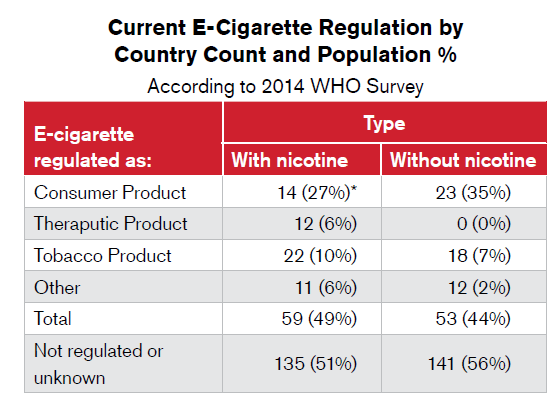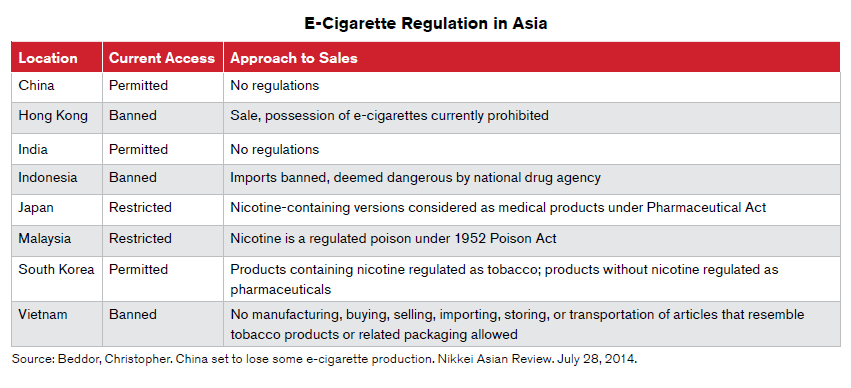Introduction
Electronic cigarettes are rapidly growing in popularity and may even eclipse traditional cigarettes in the future, barring any restrictive regulations.1 E-cigarettes were developed in China just over a decade ago, so the long-term health consequences are not yet known. The current consensus is that e-cigarettes are generally safer to the user as well as those exposed secondhand than traditional cigarettes. However, the devices still emit toxins that may be harmful to the health of the user as well as those nearby.
There are three categories of e-cigarette users: experimenters, dual-users and former smokers. Research has found that experimenters are more likely to try traditional cigarettes, which could lead to an increased prevalence in cigarette use. Because the liquid used in e-cigarettes can contain flavours that are appealing to children, there is concern that young people could become experimenters, leading to increased nicotine addiction in minors.
Population-based studies on the users of e-cigarettes conclude that dual-users are the most frequent users of e-cigarettes.2 Dual-users are those who continue to use traditional tobacco cigarettes but occasionally use e-cigarettes for convenience in places where e-cigarettes are allowed but traditional cigarettes are banned. These users may also be easing their way into e-cigarettes in an attempt to quit smoking traditional cigarettes.
E-cigarettes may be used as a smoking cessation device, especially since the liquid used in the devices can contain varying amounts of nicotine. Studies regarding the effectiveness of e-cigarettes in smoking cessation have produced conflicting results, though the World Health Organization (WHO) maintains there is insufficient evidence that e-cigarettes will decrease the prevalence of traditional cigarettes.
Global trends
E-cigarettes are gaining popularity in many countries; however, views on safety and
regulations on e-cigarettes vary widely. In some countries, such as Austria and New
Zealand, e-cigarettes are categorised as medical devices and their sales are restricted.
Other countries have banned them entirely, including Australia, Brazil, Finland,
Lebanon, Malaysia, Mexico, Panama, and Singapore. E-cigarettes are banned in Hong Kong as well. 3, 4

*The figure in parentheses after the number of countries indicates the percentage of the world population living in these countries.
Source: WHO. Electronic nicotine delivery systems. [Online] September 1, 2014. http://apps.who.int/gb/fctc/PDF/cop6/FCTC_COP6_10Rev1-en.pdf.5
Although e-cigarettes were originally invented in China, their local popularity has not kept pace with that of other countries. Smokers in China do not face the same bans on smoking in public places or the relatively high cost of tobacco cigarettes. In addition, there are no public health campaigns discouraging tobacco cigarettes or encouraging a move to e-cigarettes.6
In the U.K., more than 2 million people use e-cigarettes, and it is estimated that the number of users has tripled in the past two years. A study of e-cigarette use in the U.K. concluded that the majority of users are attempting to quit smoking traditional tobacco cigarettes, while only 1% are new users or experimenters who did not previously smoke tobacco cigarettes. Approximately 700,000 are former smokers, while about 1.3 million are dual-users.7 E-cigarettes have become
the most popular tobacco cessation device in the U.K., as 25% of those attempting to quit choose e-cigarettes.8
E-Cigarettes as a smoking cessation device
WHO reported in August 2014 that there is insufficient evidence that e-cigarettes can help smokers break the habit, and it is urging regulatory action to ban e-cigarette manufacturers from making such claims. It advises that smokers should opt for one of the currently approved smoking cessation products instead, such as nicotine patches and gum or prescription medications.5
However, studies have reached varying conclusions on this issue. One study carried out by the University College London concluded that smokers were nearly 60% more likely to succeed in their attempts to quit smoking if they used e-cigarettes as opposed to other smoking cessation devices or no help at all. Approximately 6,000 smokers who had tried to quit within the past 12 months were surveyed for this study, which was carried out from 2009 to 2014 and published in the journal Addiction. At the time of the survey, 20% of the participants reported that they had stopped smoking conventional cigarettes with the aid of e-cigarettes. This was a higher quit rate than any of the other study groups experienced without e-cigarettes.9, 10
E-Cigarette Regulation in Asia
WHO reported in August 2014 that there is insufficient evidence that e-cigarettes can help smokers break the habit, and it is urging regulatory action to ban e-cigarette manufacturers from making such claims. It advises that smokers should opt for one of the currently approved smoking cessation products instead, such as nicotine patches and gum or prescription medications.5
However, studies have reached varying conclusions on this issue. One study carried out by the University College London concluded that smokers were nearly 60% more likely to succeed in their attempts to quit smoking if they used e-cigarettes as opposed to other smoking cessation devices or no help at all. Approximately 6,000 smokers who had tried to quit within the past 12 months were surveyed for this study, which was carried out from 2009 to 2014 and published in the journal Addiction. At the time of the survey, 20% of the participants reported that they had stopped smoking conventional cigarettes with the aid of e-cigarettes. That was a higher quit rate than any of the other study groups experienced without e-cigarettes.9, 10
 On the other hand, a study published online in JAMA Internal Medicine found that e-cigarettes do not help people quit smoking. Researchers studied the 12-month quit rates of smokers who used e-cigarettes both with and without nicotine (an e-cigarette with 0 mg of nicotine in the e-liquid) as well as the quit rates of those who used a nicotine patch. There were no differences in the quit rates.
On the other hand, a study published online in JAMA Internal Medicine found that e-cigarettes do not help people quit smoking. Researchers studied the 12-month quit rates of smokers who used e-cigarettes both with and without nicotine (an e-cigarette with 0 mg of nicotine in the e-liquid) as well as the quit rates of those who used a nicotine patch. There were no differences in the quit rates.
The study concludes, “when used by a broad sample of smokers under ‘real world’ conditions, e-cigarettes did not significantly increase the chances of successfully quitting cigarette smoking.”11
Another study of tobacco quit-line callers over a seven-month period found that the probability of quitting cigarettes was lower for e-cigarette users compared to those who did not use e-cigarettes. Among those surveyed, the probability of quitting was 31.4% for those who had never tried e-cigarettes, 21.7% for those who had used e-cigarettes for longer than a month, and 16.6% for those who used e-cigarettes for less than one month.2
The U.S. Food and Drug Administration (FDA) has not yet approved the marketing of e-cigarettes as a smoking cessation device. The FDA has not fully studied e-cigarettes and states on its website, “consumers currently don’t know the potential risks of e-cigarettes when used as intended, how much nicotine or other potentially harmful chemicals are being inhaled during use, or whether there are any benefits associated with using these products.”12
Health impact
Many traditional cigarette users believe that e-cigarettes are a safer alternative. This is mostly due to e-cigarette manufacturers’ marketing campaigns promoting the benefits of e-cigarettes, or vaping, over traditional smoking. A study published in the American Journal of Preventive Medicine reviewed the marketing claims found on 59 e-cigarette websites in 2012. Of these websites, over 90% implicitly or explicitly claimed that e-cigarettes have a health benefit, 76% claimed the product does not produce secondhand smoke, and 64% advertised that e-cigarettes can help users quit smoking.2
Switching entirely from traditional cigarettes to e-cigarettes exposes the user to fewer toxins for the same amount of nicotine. However, most dual-users continue to smoke traditional cigarettes along with e-cigarettes. Many smokers believe that
cutting down on the number of traditional cigarettes smoked per day will benefit their
health. However, the effect that smoking has on one’s health is proportionate to the lifetime accumulation of exposure to tobacco and wears off only very slowly once tobacco consumption stops or is reduced. The effect of smoking on the heart and blood vessels occurs even at very low levels of smoking – indeed, smoking only one to four cigarettes per day has been associated with increased risk of cardiovascular disease, so even if a smoker is able to cut back to only a few traditional cigarettes a day, there may not be much benefit to his or her health.2
Many e-cigarette manufacturers also claim they are healthier to the public because they do not produce secondhand smoke. While e-cigarettes may produce a lower volume of toxins, they may still contain nicotine and other harmful toxins and carcinogens. Non-smokers who are exposed to secondhand vapours from an e-cigarette have been found to have similar levels of cotinine in their blood as they would have from being exposed to traditional cigarette smoke. Another study tested the aerosol exhaled from e-cigarettes and found low levels of formaldehyde, acetaldehyde, isoprene, acetic acid, 2-butanodione, acetone, propanol, propylene glycol and nicotine, although the toxins from the aerosol were at a lower level than from conventional cigarettes. These findings contradict a common advertising claim made by e-cigarette manufacturers that they only submit a harmless “water vapour.”2
The general consensus seems to be that one puff of an e-cigarette is less harmful than one puff of a traditional cigarette, but neither is good for you. If someone insists on smoking or vaping, e-cigarettes are probably less hazardous, but they are not benign. Dual-use may lead to a greater public health concern if smokers continue to smoke tobacco cigarettes for a long period of time at a lower rate rather than using other methods to quit smoking entirely.




 On the other hand, a study published online in JAMA Internal Medicine found that e-cigarettes do not help people quit smoking. Researchers studied the 12-month quit rates of smokers who used e-cigarettes both with and without nicotine (an e-cigarette with 0 mg of nicotine in the e-liquid) as well as the quit rates of those who used a nicotine patch. There were no differences in the quit rates.
On the other hand, a study published online in JAMA Internal Medicine found that e-cigarettes do not help people quit smoking. Researchers studied the 12-month quit rates of smokers who used e-cigarettes both with and without nicotine (an e-cigarette with 0 mg of nicotine in the e-liquid) as well as the quit rates of those who used a nicotine patch. There were no differences in the quit rates.
